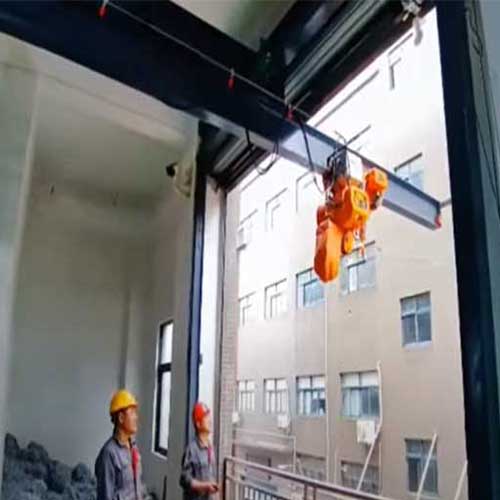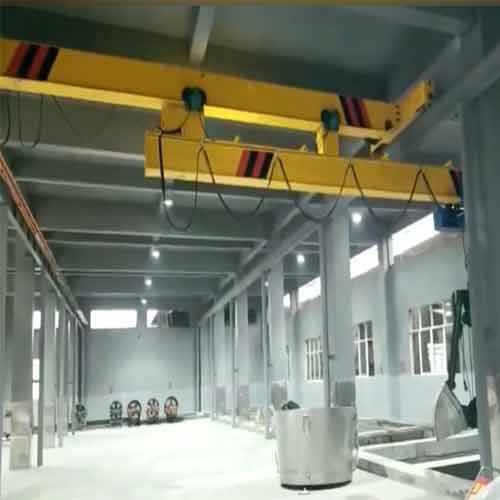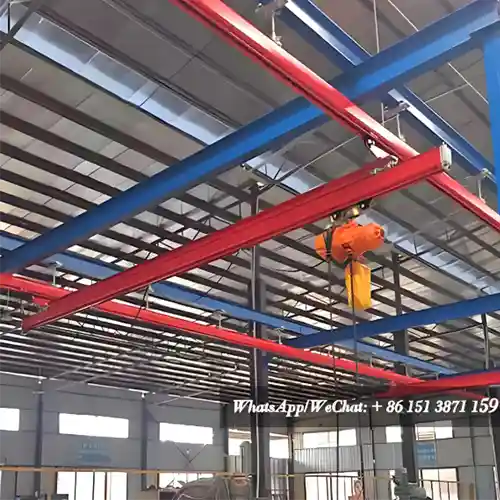Single Girder Telescoping Bridge Cantilever Cranes in Small-Scale Workshops
Telescoping cantilever bridge crane for low profile small scale workshops for handling small components, machinery parts along workstations, assembly line.
Category: Telescoping Overhead Crane
Your Trusted Low Profile Crane Manufacturer & Supplier
Single Girder Telescoping Bridge Cantilever Cranes in Small-Scale Workshops
Custom Telescoping Cantilever Bridge Crane for Low Profile Small Ccale Workshops 1 Ton to 10 Ton
Telescoping cantilever bridge crane for low profile small scale workshops for handling small components, machinery parts along workstations, assembly line.
Comprehensive Guide to Telescoping Bridge Cantilever Cranes in Confined Spaces Warehouses
In the modern logistics, efficiency and precision are key elements in optimizing warehouse operations. The Telescoping Bridge Cantilever Crane emerges as a crucial solution, designed to navigate the challenges of confined spaces with finesse. These cranes are equipped with a telescoping mechanism that extends or retracts the crane bridge, offering enhanced flexibility in handling materials within constrained warehouse environments.
The telescoping feature allows the crane to adapt to varying distances between racks or obstacles, making it an ideal choice for warehouses where space is at a premium. The flexibility to adjust the bridge length provides unparalleled versatility in handling materials of different sizes and weights.
Confined spaces warehouses pose unique challenges, requiring specialized lifting equipment to maximize space utilization and operational efficiency. Telescoping Bridge Cantilever Cranes shine in this environment, addressing the limitations of traditional cranes by offering precise and adaptable solutions. Their ability to extend or retract the bridge enables seamless navigation through narrow aisles and facilitates precise material placement, making them invaluable tools in confined spaces where traditional cranes may struggle to operate.
Telescoping Bridge Cantilever Cranes
Components and Structure
Telescoping Bridge Cantilever Cranes are sophisticated lifting systems designed to operate seamlessly in confined spaces. Understanding their key components and structure is essential for both users and potential buyers looking to harness the full potential of these specialized cranes.
- Telescoping Mechanism: The heart of the telescoping crane, this mechanism allows the bridge to extend or retract as needed. Exploring the intricacies of this feature sheds light on the crane's adaptability to varying distances between racks or obstacles. Users gain insights into the engineering behind this critical component, which influences the crane's overall versatility.
- Bridge Structure: The structural integrity of the bridge is paramount for safe and efficient operation. This section delves into the materials used, design considerations, and load bearing capacity of the bridge structure. Understanding these aspects ensures users and buyers can select a crane that aligns with the specific demands of their confined spaces warehouse.
- Hoist and Trolley: The hoist and trolley system is responsible for lifting and transporting loads within the warehouse. Examining the types of hoists and trolleys available provides valuable information on the crane's lifting capabilities. This knowledge aids in selecting the appropriate crane configuration to match the unique requirements of confined spaces.
- Control Systems: Control systems are the brains behind the crane operation. Whether manual or automated, the control systems influence precision, speed, and safety during material handling. This section explores the various control options available, providing users with insights into selecting a system that aligns with their operational preferences and safety standards.
These components and their interplay, users and buyers can make informed decisions, ensuring that Telescoping Bridge Cantilever Cranes meet the specific demands of confined spaces warehouses while delivering optimal performance.
Types of Telescoping Bridge Cantilever Cranes
The diversity in the design and functionality of Telescoping Bridge Cantilever Cranes caters to the varied needs of confined spaces warehouses. Understanding the different types helps users and buyers choose the most suitable crane for their specific operational requirements.
In the dynamic realm of industrial lifting equipment, telescoping cantilever bridge cranes stand out as versatile solutions designed to meet the demands of various manufacturing environments. These innovative crane systems are engineered to provide precision, efficiency, and adaptability in material handling processes. Two prominent variations within this category are the Top Running Telescoping Cantilever Bridge Cranes and Underhung Running Telescoping Cantilever Bridge Cranes.
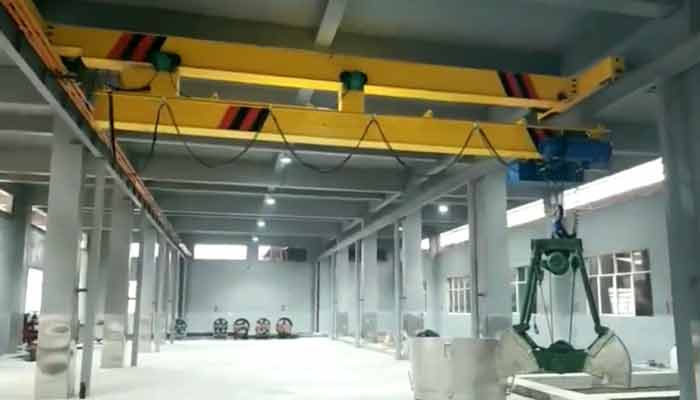
Top Running Telescoping Cantilever Bridge Cranes:
Top Running Telescoping Cantilever Bridge Cranes are characterized by their overhead configuration, where the crane travels on an elevated runway system. The term "top running" refers to the placement of the crane's wheels on the upper part of the runway beam, allowing it to carry and move heavy loads efficiently. The telescoping feature in these cranes enables the horizontal extension of the crane's arm, providing enhanced reach and flexibility in material handling tasks. This design makes Top Running Telescoping Cantilever Bridge Cranes suitable for applications requiring precision, stability, and the ability to cover expansive work areas.
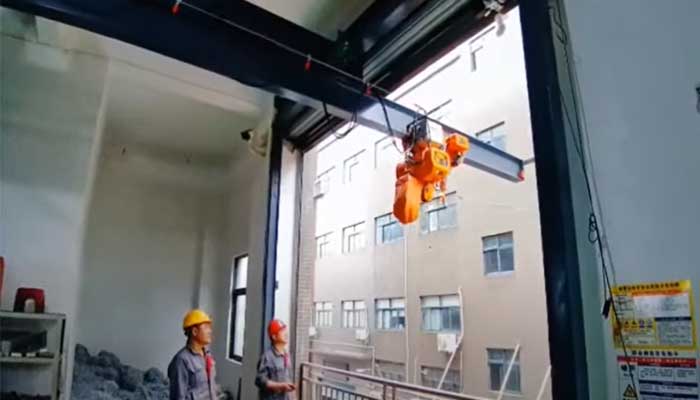
Underhung Running Telescoping Cantilever Bridge Cranes:
On the other hand, Underhung Running Telescoping Cantilever Bridge Cranes operate on an inverted runway system, with the crane's wheels running on the lower part of the beam. This configuration allows the crane to be suspended from the ceiling, creating a compact and space efficient solution. The telescoping functionality in these cranes provides a horizontal reach, making them adept at navigating through tight spaces and reaching into confined areas within a manufacturing facility. Underhung Running Telescoping Cantilever Bridge Cranes are often chosen for applications where floor space is a premium, and a flexible material handling solution is required.
Similarities:
- Telescoping Feature: Both Top Running and Underhung Telescoping Cantilever Bridge Cranes share the commonality of a telescoping mechanism. This feature enables the horizontal extension of the crane's arm, offering increased reach and adaptability in material handling tasks.
- Precision in Material Handling: Both variations are designed to provide precise and controlled material handling capabilities. The telescoping feature enhances the crane's ability to position loads with accuracy, contributing to the efficiency of manufacturing processes.
Differences:
- Configuration and Runway System: The primary distinction lies in their configuration and runway systems. Top Running Cranes travel on an elevated runway system, while Underhung Cranes operate on an inverted or suspended runway system.
- Space Utilization: Top Running Cranes are well suited for applications where vertical space is ample, providing an overhead solution. Underhung Cranes, on the other hand, excel in environments where floor space is limited, utilizing the ceiling space for efficient material handling.
The characteristics and differences between Top Running and Underhung Telescoping Cantilever Bridge Cranes is crucial for selecting the most suitable solution based on the specific requirements of a given manufacturing facility. Whether optimizing overhead space or maximizing floor space, these cranes offer tailored solutions for diverse material handling needs.
Comparasions of telescoping bridge crane with other types of low headroom overhead cranes for confined space
When comparing Telescoping Bridge Cranes with other types of low headroom overhead cranes for confined spaces, several factors come into play. Each type of crane has its own set of characteristics, advantages, and limitations. Let's compare Telescoping Bridge Cranes with two common alternatives: Single Girder Overhead Cranes and Double Girder Overhead Cranes, specifically designed for low headroom applications.

Advantages:
Compact Design: Telescoping cranes are known for their space efficient design, making them suitable for confined spaces where vertical and horizontal space is limited.
Variable Reach: The telescoping feature allows the crane to extend horizontally, providing flexibility in material handling tasks within constrained work areas.
Adaptability: Suitable for applications with varying load sizes and weights, offering versatility in handling different types of materials.
Precision Control: Enables accurate positioning of loads, contributing to enhanced efficiency in confined spaces.
Limitations:
Load Capacity: While telescoping cranes are versatile, their load capacity may be lower compared to some double girder cranes, limiting their application in heavy duty scenarios.
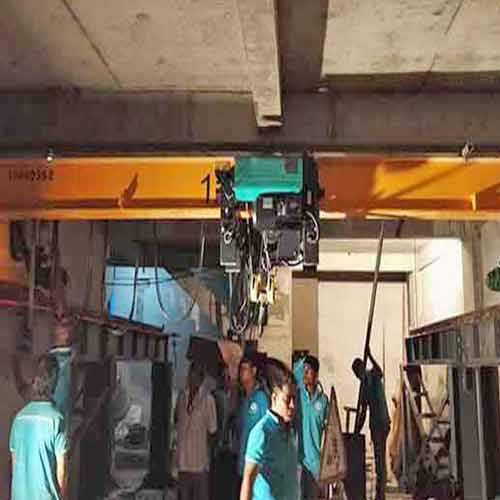
Single Girder Overhead Cranes (Low Headroom):
Advantages:
Low Headroom Design: Specifically engineered for low headroom applications, providing efficient use of vertical space in confined environments.
Cost Effective: Generally more cost effective than double girder cranes, making them an economical choice for certain applications.
Ease of Installation: Easier to install and maintain compared to double girder cranes, reducing downtime during setup.
Limitations:
Load Capacity: Single girder cranes may have lower load capacities compared to double girder cranes, limiting their application in heavy duty industries.
Span Limitations: May have span limitations, restricting their suitability for larger workspaces.
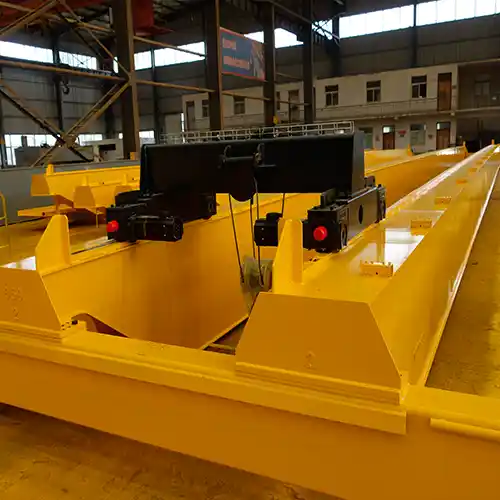
Double Girder Overhead Cranes (Low Headroom):
Advantages:
High Load Capacity: Designed for heavy duty applications, providing a higher load capacity compared to single girder and telescoping cranes.
Stability: The double girder configuration enhances stability and precision, making them suitable for tasks requiring high accuracy.
Versatility: Suitable for a wide range of applications, including those with demanding load requirements.
Limitations:
Cost: Generally, double girder cranes are more expensive than single girder and telescoping cranes, which can impact the overall budget.
Space Requirements: The double girder design may not be as space efficient as telescoping or single girder cranes in confined environments.
The choice between Telescoping Bridge Cranes, Single Girder Overhead Cranes, and Double Girder Overhead Cranes for confined spaces depends on specific application requirements, load capacities, and budget considerations. Telescoping cranes are particularly advantageous for their compact design and variable reach, making them well suited for confined spaces with diverse material handling needs. Single girder cranes offer a balance between cost effectiveness and performance, while double girder cranes excel in heavy duty applications with higher load capacities. Careful consideration of these factors will help users make informed decisions based on the unique demands of their confined space environments.
Telescoping cantilever bridge crane vs Telescoping Cantilever Gantry Crane vs Telscoping Cantilever Jib Cranes
When comparing Telescoping Cantilever Bridge Cranes, Telescoping Cantilever Gantry Cranes, and Telescoping Cantilever Jib Cranes, it's essential to understand the key differences in their designs, applications, and functionalities. Each type of crane is tailored to specific material handling requirements, and the choice depends on factors such as space availability, load capacity, and maneuverability. Let's explore the distinctions between these three types of telescoping cranes:
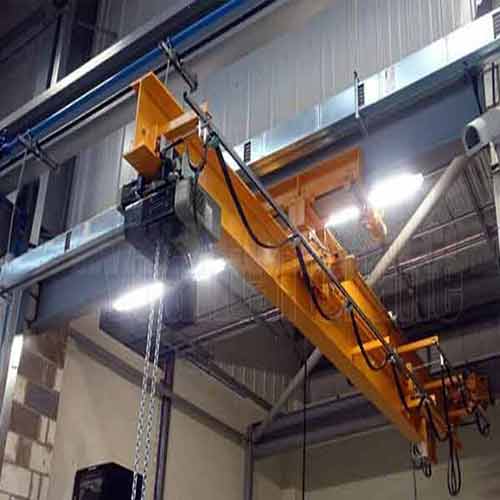
Telescoping Cantilever Bridge Crane:
Design and Functionality:
Configuration: Overhead crane with a horizontal bridge supported by vertical legs.
Movement: Travels along an elevated runway system.
Reach: Telescoping feature allows the horizontal extension of the crane's arm for increased reach.
Applications: Well suited for confined spaces with overhead clearance, offering efficient material handling and precise load positioning on assembly lines or workstations.
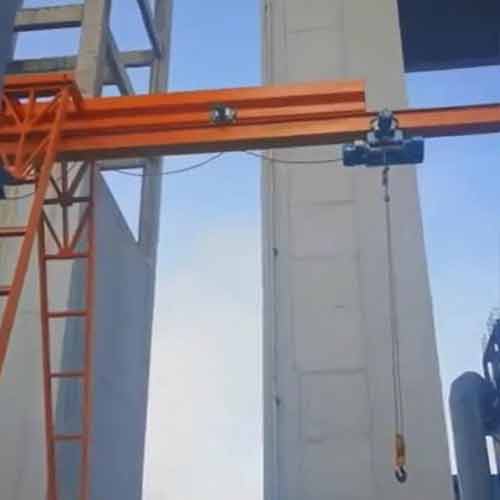
Telescoping Cantilever Gantry Crane:
Design and Functionality:
Configuration: Similar to a bridge crane but with legs supported on the ground, providing a mobile and self supporting structure.
Movement: Gantry cranes move along a track on the ground.
Reach: Telescoping feature extends horizontally, offering flexibility in reaching and lifting loads.
Applications: Versatile for outdoor and indoor applications, commonly used in shipping yards, construction sites, and manufacturing facilities where a fixed runway system may not be feasible.
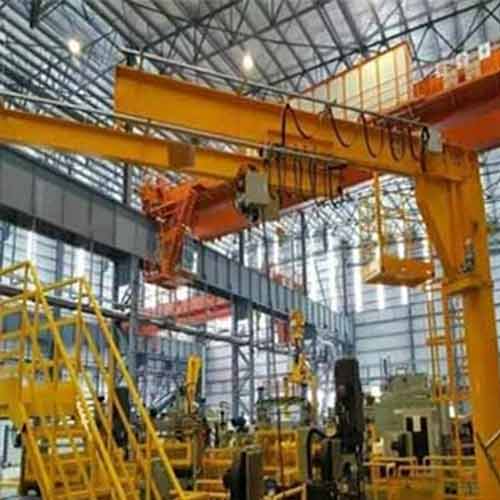
Telescoping Cantilever Jib Crane:
Design and Functionality:
Configuration: Vertical post supporting a horizontal jib arm with a telescoping feature.
Movement: Rotation around the vertical post and telescoping extension for horizontal reach.
Reach: Designed for localized material handling within a specific area, providing a flexible and space saving solution.
Applications: Ideal for individual workstations, machine tool operations, or assembly areas where precision and agility are crucial.
Comparison of Types of Telescoping Jib Cranes
Mobility:
Bridge Crane: Fixed along an overhead runway system.
Gantry Crane: Mobile and self supporting, can move along the ground.
Jib Crane: Typically fixed but can have a rotating base for localized movement.
Reach and Flexibility:
Bridge Crane: Ideal for precise material handling in confined spaces with overhead clearance.
Gantry Crane: Suitable for applications where the crane needs to cover a larger area on the ground.
Jib Crane: Offers localized reach and flexibility, suitable for specific workstations or areas.
Applications:
Bridge Crane: Assembly lines, manufacturing workstations with overhead clearance.
Gantry Crane: Construction sites, shipping yards, outdoor material handling.
Jib Crane: Individual workstations, machine tool operations, assembly areas.
Installation:
Bridge Crane: Requires an overhead runway system.
Gantry Crane: Self supporting and mobile, minimal installation requirements.
Jib Crane: Can be wall mounted or freestanding, flexible installation options.
In summary, the choice between Telescoping Cantilever Bridge Cranes, Telescoping Cantilever Gantry Cranes, and Telescoping Cantilever Jib Cranes depends on the specific material handling needs, available space, and mobility requirements of the application. Each type offers unique advantages, and selecting the right crane involves considering factors such as reach, mobility, and the spatial constraints of the work environment.
Load Capacity and Specifications
The load capacity and specifications of Telescoping Bridge Cantilever Cranes are critical considerations that directly impact their performance and safety in confined spaces warehouses.
Tailoring Crane Capacity to Warehouse Requirements:
Selecting the appropriate capacity for Telescoping Cantilever Bridge Cranes is paramount to ensuring safe and efficient operations in confined spaces. Here are key considerations and expert insights to guide users and buyers through this crucial step:
- Assessing Load Types and Weights: Begin by conducting a thorough assessment of the types and weights of loads commonly handled in the confined spaces warehouse. Consider the maximum load dimensions and any potential variations in load characteristics.
- Understanding Crane Capacity Ratings: Telescoping cranes come with specific capacity ratings indicating the maximum load they can safely lift. These ratings account for both static and dynamic loads. It's crucial to understand these ratings and ensure they align with the heaviest loads the crane is expected to handle.
- Factor in Load Variability: Confined spaces may require handling a variety of loads with different weights. Anticipate load variability and choose a crane with a capacity that comfortably accommodates the heaviest potential loads. This ensures flexibility and adaptability in material handling processes.
- Practical Advice for Capacity Considerations: Industry experts recommend selecting a crane with a capacity that exceeds the expected maximum load by a comfortable margin. This provides a safety buffer, preventing the crane from operating near its maximum limits and ensuring longevity of the equipment.
- Consulting with Crane Specialists: When in doubt about the appropriate capacity for specific warehouse requirements, consult with crane specialists or engineers. They can conduct a comprehensive analysis of load characteristics, workspace constraints, and operational needs to provide tailored recommendations.
- Consider Future Growth: Plan for future growth and changes in load requirements. Choosing a telescoping crane with a capacity that accommodates potential expansions or modifications in warehouse operations ensures a more sustainable and cost effective solution in the long run.
By carefully tailoring the crane capacity to the unique requirements of the confined spaces warehouse, users and buyers can enhance safety, efficiency, and overall performance. This proactive approach minimizes the risk of overloading issues and ensures that the telescoping crane is a reliable asset in meeting material handling demands.
Adherence to Safety Standards:
Ensuring the safety of material handling operations in confined spaces is non negotiable. Here's a comprehensive guide on prioritizing safety standards when selecting and operating Telescoping Cantilever Bridge Cranes:
- Compliance with Industry Regulations: Begin by identifying and understanding the industry specific safety regulations governing material handling equipment in confined spaces. Different regions and industries may have distinct standards, and it is imperative to adhere to them for legal and operational reasons.
- Built In Safety Features: Telescoping cranes should be equipped with a range of safety features designed to prevent accidents and ensure the well being of personnel. Look for features such as overload protection, emergency stop mechanisms, and collision avoidance systems. These features contribute to safer crane operations.
- Certifications and Compliance Documentation: Prioritize telescoping cranes that come with relevant certifications and compliance documentation. Certifications from recognized bodies verify that the crane meets or exceeds safety standards. Review these documents carefully and ensure they align with the specific safety requirements of confined spaces.
- Operator Training and Certification: Safety is not only about the equipment but also about the individuals operating the crane. Ensure that crane operators receive comprehensive training and hold the necessary certifications. Well trained operators are more adept at handling the equipment safely and responding to unexpected situations.
- Regular Inspections and Maintenance: Implement a rigorous inspection and maintenance schedule for telescoping cranes. Regular inspections, conducted by qualified professionals, help identify and address potential safety issues before they escalate. Proactive maintenance is key to ensuring that safety features remain in optimal working condition.
- Emergency Preparedness: Establish clear emergency protocols and procedures for confined spaces. Crane operators and other personnel should be well versed in these protocols to respond swiftly in the event of an emergency. Conduct periodic drills to reinforce emergency preparedness.
- Industry Best Practices: Stay informed about industry best practices related to crane safety in confined spaces. Engage with industry forums, attend conferences, and collaborate with safety experts to stay updated on evolving safety standards and recommendations.
- Feedback Mechanisms: Establish effective communication channels for reporting safety concerns or incidents. Encourage a culture of reporting and learning from near misses to continuously improve safety protocols.
By prioritizing adherence to safety standards, users and buyers can create a secure working environment in confined spaces. Telescoping Cantilever Bridge Cranes that meet or exceed safety regulations contribute to accident prevention, employee well being, and the overall success of material handling operations.
Typical applications of Typical Telescoping Cantilever Bridge Cranes.
Typical Applications of Telescoping Cantilever Bridge Cranes:
Telescoping Cantilever Bridge Cranes, including both Top Running and Underhung variations, find application across a broad spectrum of industries where efficient and precise material handling is essential. Some typical applications include:
- Manufacturing and Assembly Lines: Telescoping Cantilever Bridge Cranes are commonly employed in manufacturing and assembly processes, facilitating the movement and positioning of heavy components with precision.
- Automotive Industry: These cranes play a crucial role in the automotive sector for tasks such as lifting and positioning car bodies, transporting components along assembly lines, and aiding in the production of various vehicle parts.
- Warehousing and Logistics: Telescoping Cantilever Bridge Cranes are utilized in warehouses for the efficient loading and unloading of goods, as well as the movement of materials within storage facilities.
- Aerospace Industry: In the aerospace industry, where precision is paramount, these cranes assist in handling large and delicate aircraft components during manufacturing and assembly processes.
- Heavy Machinery Production: Industries involved in the production of heavy machinery, such as construction equipment or industrial machinery, benefit from the lifting capacity and precision offered by Telescoping Cantilever Bridge Cranes.
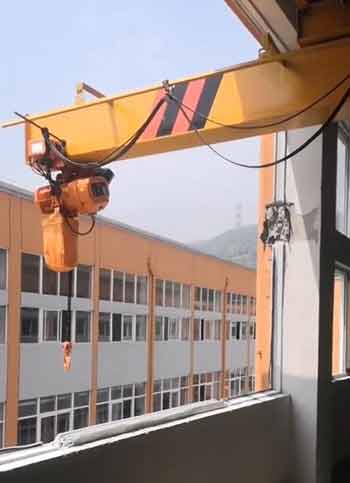
Telescoping cantilever bridge under running overhead crane for high building use for material handling
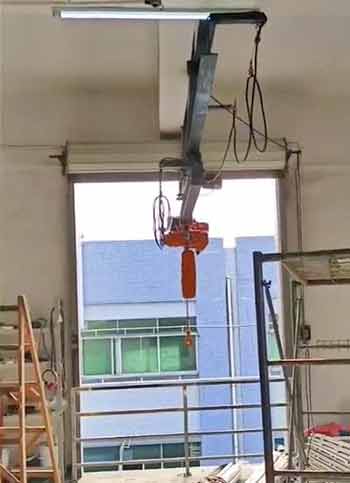
Ceiling mounted low headroom overhead bridge crane with telescoping cantilever crane design and electric chain hoist
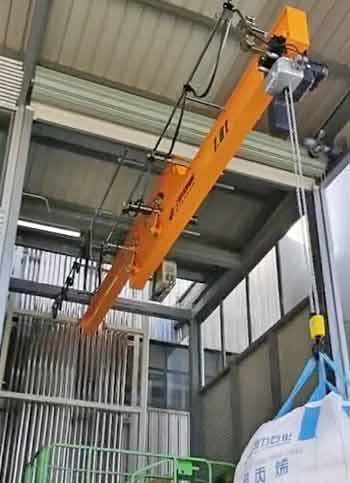
Underhung bridge crane with telescoping cantilever for material handling accross doors, columns and other obstacles efficiently.
Features and Benefits of Top Running Telescoping Cantilever Bridge Cranes:
- Overhead Configuration: The top running design allows these cranes to operate on an elevated runway system, providing ample clearance and enabling them to cover large work areas efficiently.
- Enhanced Stability: The elevated positioning of the crane contributes to enhanced stability and load carrying capacity, making Top Running Telescoping Cantilever Bridge Cranes suitable for lifting heavy loads.
- Extended Reach: The telescoping feature allows the crane to extend horizontally, providing increased reach for precise material handling and positioning.
- Adaptability: These cranes are adaptable to various manufacturing environments and are suitable for applications where vertical space is not a constraint.
Features and Benefits of Underhung Running Telescoping Cantilever Bridge Cranes:
- Inverted Runway System: The underhung design allows these cranes to operate on an inverted runway system, making them suitable for environments with limited floor space.
- Space Efficiency: Underhung Cranes are known for their space saving design, utilizing the ceiling space rather than occupying floor space, making them ideal for compact manufacturing facilities.
- Maneuverability in Confined Spaces: The underhung configuration, combined with the telescoping feature, allows for enhanced maneuverability in tight spaces and efficient handling of materials in confined areas.
- Flexible Material Handling: Underhung Running Telescoping Cantilever Bridge Cranes are versatile and adaptable, making them well suited for applications that require precise material handling in changing or constrained environments.
Both types of Telescoping Cantilever Bridge Cranes share the fundamental advantage of providing precise and efficient material handling capabilities. The choice between Top Running and Underhung variations depends on specific operational requirements, spatial constraints, and the nature of the materials being handled in a given industrial setting.
Benefits of Telescoping Bridge Cantilever Cranes in Confined Spaces Warehouses
The advantages of Telescoping Bridge Cantilever Cranes in confined spaces warehouses extend beyond their unique design. These benefits enhance operational efficiency and safety, making them indispensable tools in material handling within limited workspace environments.
Precision Handling in Tight Spaces
Telescoping cranes excel in navigating tight spaces with unparalleled precision. The ability to extend or retract the bridge allows for precise placement of loads even in the narrowest aisles or between racks. This precision handling minimizes the risk of collisions and damage to inventory, ensuring that materials can be moved with accuracy in confined spaces.
Vertical Space Utilization
Confined spaces warehouses often face the challenge of limited horizontal space. Telescoping Bridge Cantilever Cranes overcome this limitation by not only moving horizontally but also utilizing vertical space effectively. The telescoping mechanism allows the crane to reach varying heights, making it possible to access materials stored on different levels within the warehouse. This vertical space utilization optimizes storage capacity and enhances overall warehouse efficiency.
Increased Flexibility and Maneuverability
The flexibility of telescoping cranes is a standout feature in confined spaces. These cranes can adapt to changing conditions, adjusting the length of the bridge as needed. This increased flexibility enables seamless maneuverability through narrow passages and around obstacles. Whether handling irregularly shaped loads or navigating complex warehouse layouts, telescoping cranes provide the versatility required for efficient material handling.
Enhanced Safety Measures
Safety is a primary concern in confined spaces, and telescoping cranes are designed with safety features to address this concern. The precise control offered by the telescoping mechanism reduces the risk of accidents, and additional safety features, such as overload protection and emergency stop mechanisms, further enhance the safety of crane operations in confined spaces. This section explores the safety measures integrated into telescoping cranes, emphasizing their role in creating a secure working environment.
These benefits positions Telescoping Bridge Cantilever Cranes as indispensable tools for confined spaces warehouses, where precision, flexibility, and safety are paramount.
Choosing the Right Telescoping Bridge Cantilever Crane
Selecting the right Telescoping Bridge Cantilever Crane for a confined spaces warehouse involves a careful evaluation of various factors. This decision making process ensures that the chosen crane aligns with the unique requirements of the workspace while prioritizing safety and efficiency.
Warehouse Layout Considerations
The layout of the confined spaces warehouse is a pivotal factor in choosing a suitable telescoping crane. Assessing the arrangement of racks, aisles, and workstations helps determine the required reach and maneuverability. This section provides practical guidance on evaluating warehouse layouts, offering insights into how the telescoping crane can be customized to seamlessly integrate into the existing structure for optimal material handling.
Understanding Load Characteristics
To tailor the telescoping crane to the warehouse's needs, a thorough understanding of load characteristics is essential. This includes assessing the types of materials, their weights, and any special handling requirements. By comprehending load characteristics, users and buyers can choose a crane with the appropriate capacity and features to meet the specific demands of the confined spaces warehouse. This section delves into the critical aspects of load assessment and how it influences crane selection.
Budget Constraints and Cost Effectiveness
Budget considerations play a significant role in the decision making process. This section guides users and buyers through evaluating budget constraints and explores the cost effectiveness of different telescoping crane options. By understanding the long term value and return on investment, stakeholders can make informed decisions that align with financial considerations while ensuring the chosen crane meets operational requirements.
Safety Features and Compliance
Ensuring the safety of operations is non negotiable when selecting a telescoping crane. This section underscores the importance of safety features and compliance with industry standards. It explores the key safety elements to look for in a crane, such as emergency stop mechanisms, overload protection, and adherence to relevant regulations. Prioritizing safety features ensures a secure working environment and compliance with safety standards in confined spaces.
By carefully considering warehouse layout, load characteristics, budget constraints, and safety features, users and buyers can confidently choose the right Telescoping Bridge Cantilever Crane that harmonizes with the unique demands of their confined spaces warehouse.
Installation and Maintenance
Efficient installation and ongoing maintenance are crucial for the optimal performance of Telescoping Bridge Cantilever Cranes in confined spaces warehouses. This section provides a comprehensive guide to ensure a smooth installation process and outlines best practices for regular maintenance.
Site Preparation in Confined Spaces
Before installing a telescoping crane in a confined space, thorough site preparation is essential. This involves assessing the available space, confirming structural integrity, and ensuring proper foundation support. In confined spaces, the challenges are amplified, and this section provides practical insights into navigating these challenges to create an environment conducive to safe and effective crane operation.
Telescoping Crane Installation Process
The installation process of a telescoping crane requires precision and adherence to specific procedures. This section outlines step by step guidelines for installing Telescoping Bridge Cantilever Cranes in confined spaces warehouses. From assembling key components to calibrating the telescoping mechanism, users and buyers will gain insights into ensuring a seamless installation that aligns with safety standards and operational efficiency.
Regular Maintenance Guidelines for Efficient Operation
Proactive and regular maintenance is paramount for the longevity and optimal performance of telescoping cranes. This section provides comprehensive guidelines on routine maintenance practices, including inspections, lubrication schedules, and component checks. Understanding the maintenance requirements and incorporating them into the confined spaces warehouse's operational routine will contribute to the crane's reliability and minimize downtime.
Troubleshooting Specific Issues in Confined Spaces
Given the challenges posed by confined spaces, it's essential to be prepared for potential issues that may arise during crane operations. This section equips users and maintenance personnel with the knowledge to troubleshoot specific problems that may be unique to confined spaces. Practical tips and solutions are provided to address issues promptly and efficiently, ensuring uninterrupted and safe crane operations.
By following the guidelines for site preparation, installation, regular maintenance, and troubleshooting, users and buyers can maximize the efficiency and longevity of Telescoping Bridge Cantilever Cranes in confined spaces warehouses.
Safety Measures and Training
Ensuring the safety of both operators and the confined spaces warehouse environment is paramount when utilizing Telescoping Bridge Cantilever Cranes. This section focuses on comprehensive safety measures and training protocols to create a secure working environment.
Safety Protocols for Operators in Confined Spaces
Operators play a crucial role in maintaining a safe work environment. This section outlines specific safety protocols for operators working with Telescoping Bridge Cantilever Cranes in confined spaces. Topics include the proper use of personal protective equipment (PPE), communication protocols, and best practices for safe material handling. Implementing these protocols enhances the overall safety of crane operations.
Emergency Procedures Specific to Telescoping Cranes
Despite rigorous safety measures, emergencies can occur. This part of the guide provides detailed emergency procedures specific to Telescoping Bridge Cantilever Cranes in confined spaces. From power failures to equipment malfunctions, having a well defined emergency response plan ensures the safety of personnel and minimizes the impact on warehouse operations. Clear protocols for evacuation, communication, and crisis management are emphasized.
Specialized Training Programs for Crane Operators
A well trained operator is fundamental to the safe and efficient operation of telescoping cranes. This section explores the importance of specialized training programs for crane operators working in confined spaces. It covers theoretical knowledge, practical skills, and on the job training, ensuring that operators are well equipped to handle the unique challenges presented by confined spaces. Regular refresher courses and updates on safety standards are also highlighted.
Importance of Regular Inspections in Confined Spaces
Regular inspections are critical for identifying potential issues before they escalate. This section underscores the importance of routine inspections for Telescoping Bridge Cantilever Cranes in confined spaces. The inspection checklist covers mechanical, electrical, and structural components, ensuring that the crane operates at peak efficiency while adhering to safety standards. By incorporating regular inspections into the operational routine, users can maintain a secure working environment.
Prioritizing safety protocols, emergency procedures, specialized training, and regular inspections fosters a culture of safety, ensuring the effective and secure operation of Telescoping Bridge Cantilever Cranes in confined spaces warehouses.
Case Studies and Success Stories
Examples of Confined Spaces Warehouses Implementing Telescoping Cranes
This section delves into real life case studies, showcasing confined spaces warehouses that have successfully implemented Telescoping Bridge Cantilever Cranes. These examples highlight the challenges faced by each warehouse, the decision making process in choosing telescoping cranes, and the positive impact on operational efficiency. By examining these practical applications, users and buyers gain valuable insights into how similar solutions can be tailored to their unique confined spaces environments.
Challenges Faced and Overcome in Tight Spaces
Implementing new equipment, especially in confined spaces, comes with its set of challenges. This part of the guide explores the common challenges faced by warehouses during the adoption of Telescoping Bridge Cantilever Cranes. From maneuvering through narrow spaces to addressing specific load requirements, understanding the challenges and the strategies employed to overcome them provides valuable knowledge for prospective users and buyers.
Lessons Learned for Efficient Crane Utilization
Building on the experiences shared in the case studies, this section focuses on the lessons learned by confined spaces warehouses that integrated telescoping cranes into their operations. Whether related to selecting the right crane, overcoming operational hurdles, or refining safety protocols, these lessons offer practical insights. By understanding the experiences of others, warehouses can make more informed decisions, anticipate potential issues, and optimize the implementation of telescoping cranes in their own confined spaces settings.
Underhung bridge crane with telescoping cantilever crane design
Top running single girder overhead crane with telescoping cantilever or sliding cantilever design
Frequently Asked Questions (FAQs)
Common Queries from Users and Buyers in Confined Spaces
In the realm of material handling, Telescoping Cantilever Bridge Cranes stand out as efficient solutions, especially in confined spaces. As users and buyers navigate the complexities of integrating these cranes into their operations, several common queries and concerns often arise. This section aims to address these frequently asked questions, providing valuable insights into technical specifications, safety features, and operational considerations. By offering clarity on these aspects, users and buyers can make informed decisions about the implementation of Telescoping Bridge Cantilever Cranes in confined spaces.
What are the Typical Applications of Telescoping Cantilever Bridge Cranes in Confined Spaces?
Telescoping Cantilever Bridge Cranes find versatile applications in confined spaces, including:
Assembly Lines: Efficient handling of components in tight production spaces.
Maintenance Work: Facilitating repairs and maintenance in areas with limited accessibility.
Storage Facilities: Optimizing vertical storage with precise material handling.
Workstations: Providing flexibility in material placement for streamlined processes.
What are the Key Features of Telescoping Cantilever Bridge Cranes for Confined Spaces?
Telescoping Mechanism: Horizontal arm extension for increased reach in tight spaces.
Compact Design: Space efficient configuration, suitable for constrained environments.
Precision Controls: Enables accurate positioning of loads in confined areas.
Safety Features: Incorporation of safety measures to ensure secure operation.
What Benefits Do Top Running Telescoping Cantilever Bridge Cranes Offer in Confined Spaces?
Overhead Configuration: Utilizes vertical space efficiently.
Enhanced Reach: Telescoping feature provides flexibility in material handling.
Stability: Top running design offers stability for precise load positioning.
What Benefits Do Underhung Running Telescoping Cantilever Bridge Cranes Provide in Confined Spaces?
Space Optimization: Suspended design maximizes floor space.
Maneuverability: Well suited for navigating through tight spaces.
Flexibility: Adaptable to confined work areas with varying layouts.
How Can Telescoping Cantilever Bridge Cranes Enhance Safety in Confined Spaces?
Overload Protection: Prevents exceeding weight capacity for safe operations.
Emergency Stop Mechanism: Rapid response capability in case of unforeseen issues.
Operator Training: Ensures personnel are well trained for safe crane operation.
Collision Avoidance Systems: Minimizes the risk of collisions in confined environments.
What Considerations Should Be Taken Regarding Runway Systems in Confined Spaces?
Optimized Layout Planning: Ensures efficient crane movement within the confined area.
Ceiling Mounted Options: Underhung cranes maximize floor space.
Load Bearing Capacity: Runway systems must support the crane and anticipated loads.
This comprehensive guide aims to address these common queries and concerns, providing valuable information for users and buyers exploring the implementation of Telescoping Cantilever Bridge Cranes in confined spaces. By understanding the applications, features, and safety considerations, stakeholders can make well informed decisions tailored to the unique requirements of their operations.
Expert Answers and Solutions for Telescoping Cranes in Confined Spaces
To complement the common queries, this part of the guide provides expert answers and solutions from industry professionals and crane specialists. Drawing on their knowledge and experience, experts offer insights into best practices, troubleshooting tips, and recommendations for optimizing telescoping crane performance in confined spaces. Users and buyers can benefit from the expertise shared in this section, gaining a deeper understanding of the intricacies involved in the selection, installation, and operation of Telescoping Bridge Cantilever Cranes in confined spaces.
In the complex world of material handling, the deployment of Telescoping Cantilever Bridge Cranes in confined spaces demands careful consideration and expertise. To provide valuable insights, industry professionals and crane specialists share their expert answers and solutions in this section. Drawing on their knowledge and experience, these experts offer guidance on best practices, troubleshooting tips, and recommendations for optimizing the performance of Telescoping Bridge Cantilever Cranes in confined spaces. Users and buyers can leverage this collective wisdom to make informed decisions regarding the selection, installation, and operation of these cranes.
Best Practices for Layout Planning in Confined Spaces:
Expert Advice: "When planning the layout for Telescoping Cantilever Bridge Cranes in confined spaces, prioritize a 3D approach. Utilize simulation tools to visualize the crane's movement, considering vertical and horizontal space. Ensure that the layout maximizes the reach of the telescoping feature while maintaining safe distances from obstacles. This approach enhances efficiency and safety in confined environments."
Troubleshooting Tips for Telescoping Mechanism Performance:
Expert Advice: "If you encounter issues with the telescoping mechanism, start with a thorough inspection of the crane's components. Check for any signs of wear, misalignment, or obstructions. Lubrication is crucial for smooth operation, so ensure proper maintenance of telescoping elements. If problems persist, consult the crane manufacturer or a qualified technician for a detailed assessment and resolution."
Safety Considerations for Operator Training:
Expert Advice: "Operator training is paramount for safe crane operation in confined spaces. Invest in comprehensive training programs that cover not only the crane controls but also safety protocols specific to confined environments. Conduct regular refresher courses to keep operators abreast of the latest safety standards and best practices. Well trained operators are crucial for accident prevention and efficient material handling."
Overcoming Challenges in Suspended Runway Systems:
Expert Advice: "When opting for Underhung Running Telescoping Cantilever Bridge Cranes, addressing challenges in the suspended runway system is crucial. Collaborate closely with structural engineers to ensure the ceiling can support the crane and loads. Implement robust inspection schedules to monitor the condition of the suspended components. Regularly assess the structural integrity and address any signs of wear or stress promptly."
Recommendations for Load Bearing Capacity Assessment:
Expert Advice: "Determining the load bearing capacity of runway systems in confined spaces is a critical aspect of crane implementation. Engage with structural engineers to conduct a thorough assessment of the facility's infrastructure. Consider not only the crane's weight but also the anticipated loads. This assessment ensures that the runway system is designed to handle the dynamic forces associated with Telescoping Cantilever Bridge Cranes."
This expert advice and solutions section serves as a valuable resource for users and buyers navigating the intricacies of Telescoping Cantilever Bridge Cranes in confined spaces. By incorporating these insights into their decision making processes, stakeholders can enhance safety, optimize performance, and ensure the successful integration of these cranes into their material handling operations.
Custom Telescope Bridge Crane for Your Needs
The implementation of Telescoping Bridge Cantilever Cranes in confined spaces warehouses brings with it the responsibility of maintaining a safe working environment. This section encourages users and buyers to prioritize safety protocols, adhere to best practices, and foster a culture of safety among all personnel involved in crane operations. By making safety a top priority, warehouses can ensure the well being of their workforce and the longevity of their equipment.
In conclusion, Telescoping Bridge Cantilever Cranes prove to be indispensable assets for confined spaces warehouses. Their ability to navigate tight spaces with precision, utilize vertical space effectively, and enhance operational flexibility makes them invaluable tools. By embracing the principles and insights shared in this guide, users and buyers can navigate the complexities of telescoping crane integration, unlocking a future of improved productivity and operational excellence in their confined spaces warehouses.
Related Products
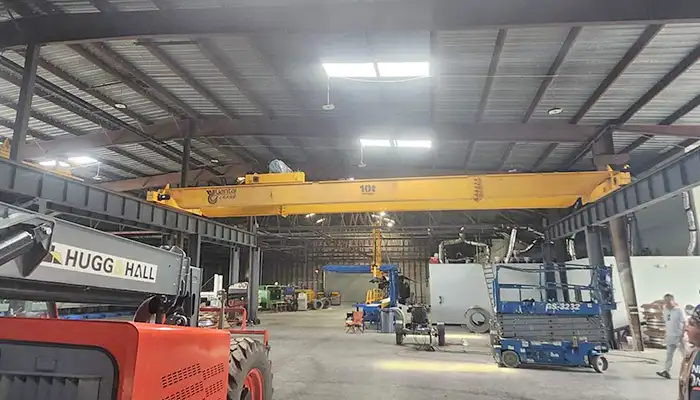
Affordable 10 ton double girder overhead crane with CD/MD hoist trolley, built for U.S. standards, ideal for construction and industrial lifting
Free consultation to Confirm Parameters & Specifications and Get
Latest Crane Price & Crane Rate.
- Types of overhead cranes : _______?
- Optional: Overhead travelling crane, goliath gantry crane,Slewing jib crane, Single girder or double girder crane,small portable crane or kbk crane, etc.
- Capacity of overhead crane: _______?
- Optional: 0.25ton, 0.5 ton, 1 ton, 2 ton, 3ton, 5 ton, 10 ton,15ton, 20ton, 25 ton, 30ton,35ton, up to 550ton, etc.
- Crane span & lifting height : _______?
- Crane travelling length : _____?
- Control of overhead crane:_______?
- Optional: pendant/ remote/cabin control
- Voltage supply of overhead crane:_____?
- Eg,: 380V50/60HZ,3Phase or others,etc.
- Application/usage of crane:_______?
- Eg,: Steel mill, ,injection mold, cement,stone, concrete,granite, general manufacturing, etc.
Just leave a message via the contact form and our hoist and crane engineer will contact you with in 24working hours.
Get In Touch
